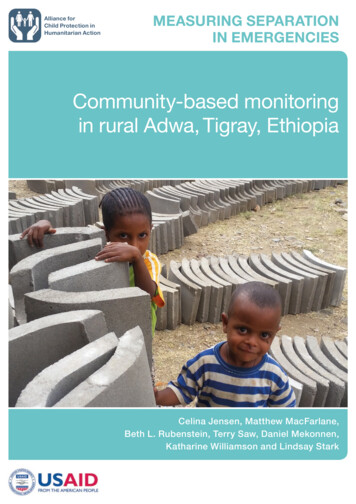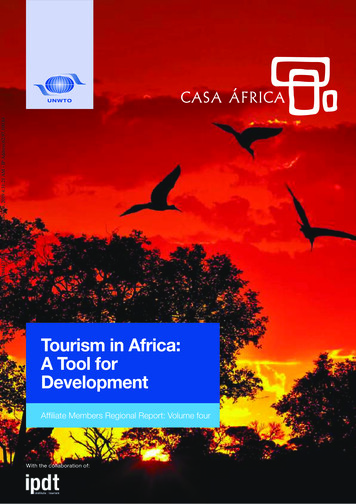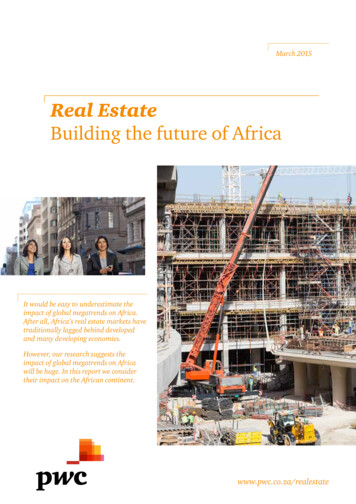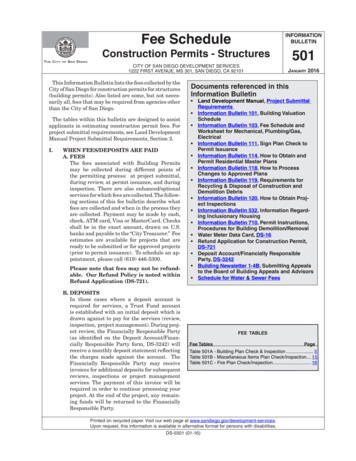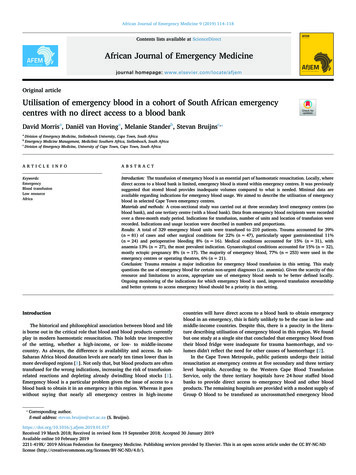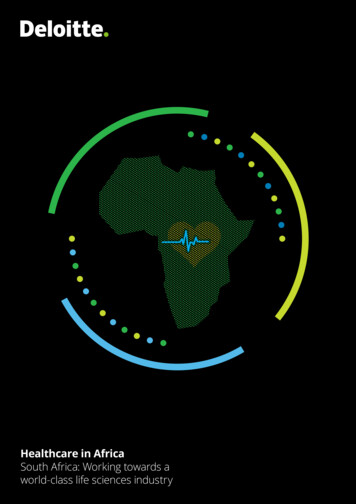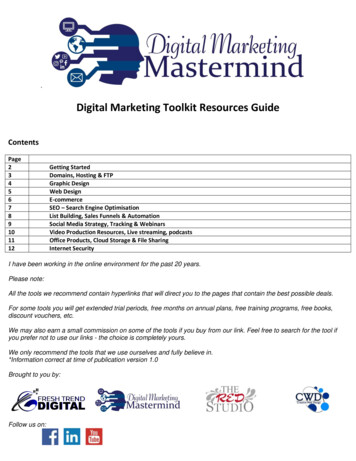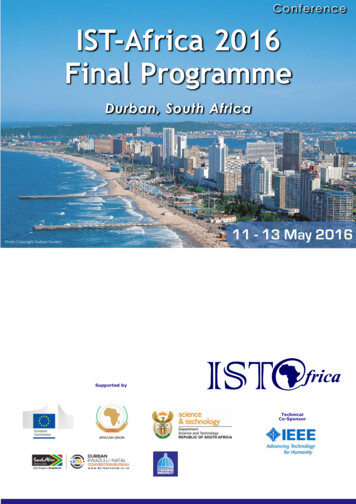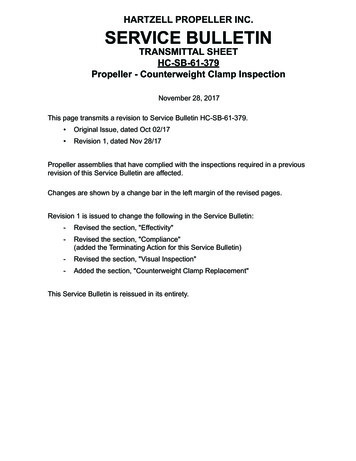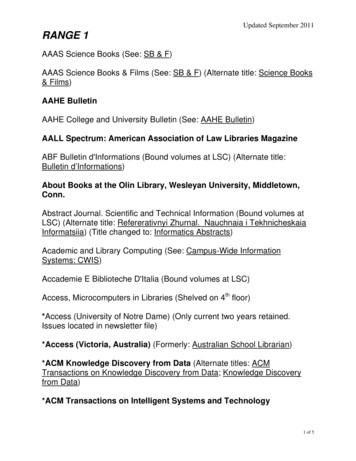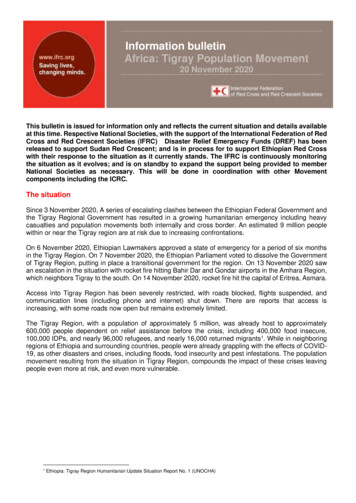
Transcription
Information bulletinAfrica: Tigray Population Movement20 November 2020This bulletin is issued for information only and reflects the current situation and details availableat this time. Respective National Societies, with the support of the International Federation of RedCross and Red Crescent Societies (IFRC) Disaster Relief Emergency Funds (DREF) has beenreleased to support Sudan Red Crescent; and is in process for to support Ethiopian Red Crosswith their response to the situation as it currently stands. The IFRC is continuously monitoringthe situation as it evolves; and is on standby to expand the support being provided to memberNational Societies as necessary. This will be done in coordination with other Movementcomponents including the ICRC.The situationSince 3 November 2020, A series of escalating clashes between the Ethiopian Federal Government andthe Tigray Regional Government has resulted in a growing humanitarian emergency including heavycasualties and population movements both internally and cross border. An estimated 9 million peoplewithin or near the Tigray region are at risk due to increasing confrontations.On 6 November 2020, Ethiopian Lawmakers approved a state of emergency for a period of six monthsin the Tigray Region. On 7 November 2020, the Ethiopian Parliament voted to dissolve the Governmentof Tigray Region, putting in place a transitional government for the region. On 13 November 2020 sawan escalation in the situation with rocket fire hitting Bahir Dar and Gondar airports in the Amhara Region,which neighbors Tigray to the south. On 14 November 2020, rocket fire hit the capital of Eritrea, Asmara.Access into Tigray Region has been severely restricted, with roads blocked, flights suspended, andcommunication lines (including phone and internet) shut down. There are reports that access isincreasing, with some roads now open but remains extremely limited.The Tigray Region, with a population of approximately 5 million, was already host to approximately600,000 people dependent on relief assistance before the crisis, including 400,000 food insecure,100,000 IDPs, and nearly 96,000 refugees, and nearly 16,000 returned migrants1. While in neighboringregions of Ethiopia and surrounding countries, people were already grappling with the effects of COVID19, as other disasters and crises, including floods, food insecurity and pest infestations. The populationmovement resulting from the situation in Tigray Region, compounds the impact of these crises leavingpeople even more at risk, and even more vulnerable.1Ethiopia: Tigray Region Humanitarian Update Situation Report No. 1 (UNOCHA)
Page 2
Page 3Population Movement2SudanAs of November 18, 2020, over 30,000 people have crossed the border to seek refuge in Sudan3, withapproximately 4,000 people crossing per day since the past 2 weeks, this is the largest influx seen inEast Sudan since the past two decades. According to data from UNHCR, 45% of those crossing theborder into Sudan are children under the age of 18, 43% are women. The majority (64%) of bordercrossings occur in Kassala State, flowed by Gedaref (34%), and Blue Nile (2%).Arrivals are temporarily hosted in transit centers located near border entry points in Al Lukdi, GedarefState and Hamdayit, Kassala State where they are screened and registered by UNHCR and localgovernment for eventual relocation to permanent camp settings. Current camp facilities in East Sudanare inadequate to receive large population influxes. The hygiene situation at the Al Lukdi and HamdayitTransit Centers is made precarious by a lack of water supply, latrines, hand washing facilities, andbathrooms. People have resorted to open defecation near the sleeping area. Fuel shortages, limitedtransportation and difficult road conditions are hampering relocation to settlement camps are causingovercrowding at the transit centers. Um-Rakoba Settlement Camp, the primary relocation site, facessimilar challenges. UNHCR is currently planning to upscale Um-Rakoba capacity from 6,500 to 10,000people.Additional shelter must be built to handle new capacity including additional food storage and procurementof HHIs such as sleeping mats, blankets, and mosquito nets. Um-Rakoba lacks a sustainable watersource and water will have to be trucked in until a more sustainable solution can be developed. WASHsupplies are needed such as family hygiene packs, dignity kits for women and girls of childbearing age.Additionally, there is a lack of hygiene infrastructure such as latrines, hand washing stations, and bathingunits.Photo by SRCS: Conducting assessments in al-Lukdi, Gedaref.Photo by SRCS: SRCS working with UNCHR near Um-Rakouba camp.2Situation as of November 18, s/resources/humanitarian bulletin 2 - 20 november 2020 - final 002.pdf32020
Page 4EthiopiaThe Ethiopia Red Cross Society (ERCS) has reported 261 internally displaced persons within Ethiopiamoving from the Alamata in Southern Tigray to the Amhara Region. Numbers of internally displacedpersons within the Tigray Region are difficult to ascertain due to lack of access and communicationshutdown in the region.Red Cross and Red Crescent ActionsIn Ethiopia, ERCS has strategically located 13 ambulances in different regions and are ready to respondas the need arises. This is complimented by a pool of skilled volunteers trained in first aid and who canserve as paramedics. The National Society has already supported the evacuation of 736 people withcombat and civilian injuries to medical facilities in Gondar. ERCS supported the 261 displaced personscoming into Amhara with food and bottled water.On 9 November 2020, three ERCS ambulances were attacked while on duty in Dansha area, NorthGondar. ERCS has called for all parties involved in the conflict to respect the Geneva Conventionproviding protection to its volunteers and its staffs and medical team who are providing help to civilianswho are not a part of the conflict. It also called on parties involved in the conflict to stop armed attackson ambulances with the Red Cross logoPhoto by ICRC: Risk of wider humanitarian emergency as fighting breaks out in the north of the countryIn Sudan, The Sudanese Red Crescent Society (SRCS) has deployed volunteers to border crossingareas since the start of the crisis to assist and provide first aid as needed. The SRCS has initiated a rapidneeds assessment along the border to better understand the current situation; to engage localgovernment, authorities, and stakeholders in the area for increased coordination; and to assess thesecurity situation; to understand immediate health, MHPSS, WASH, shelter, and protection needs. On15 November 2020 SRCS pre-positioned disaster preparedness stock in its regional warehouse for 500households including: 1,000 blankets, 1,000 mosquito nets, 1,000 tarpaulins, 1,000 sleeping mats, and1,000 water jerry cans. Distribution of items to affected populations has already begun. SCRS is alsoproviding medical aid, working through the existing SRCS health center in Hamdayit transit center wherevolunteers are also present to provide psychosocial support.
Page 5IFRC is supporting Ethiopia and Sudan by mobilizing its Disaster Relief Fund on(CHF)# of RET024498,763357,390856,15340,0007,50047,500The DREF operation in Sudan will provide emergency services to 40,000 persons crossing the borderinto Sudan from Ethiopia due to the current crisis in Hamdayit and Al-Lukdi transit centers, as well as theUm-Rakoba refugee settlement. The operation will have a focus on shelter, WASH, health, and protectionservices.The DREF operation in Ethiopia will assist 7,500 internally displaced persons with a focus on health,protection, RFL, shelter, and immediate humanitarian assistance with cash and NFIs. Assistance will befocused on the border areas with the Tigray Region and within Tigray itself once access is established.IFRC will continue to support respective National Societies for scaling up humanitarian response effortsin a coordinated manner with other Movement partners, including the ICRC; as well as other actors asappropriate.CoordinationIFRC is providing technical and financial support to ERCS and SRCS via its Eastern Africa CountryCluster Support Team as well as the Regional Office for Africa, based in Nairobi. The IFRC has apermanent representative delegation to the African Union in Ethiopia; and a Country Office in SudanICRC has a large presence in Ethiopia with a sub-delegation in Tigray. The ICRC deputy head ofdelegation was on a mission to Tigray at the onset of the armed clashes and has since remained at theMekelle ICRC sub-delegation. The ICRC field office is embedded with ERCS regional office and theywork closely. All communication is suspended for Tigray; thus, the Movement relies on a single satellitecall from ICRC for information. In Sudan, ICRC and SRCS are coordinating to do an RFL assessment.ICRC also has an ongoing collaboration with the Kassala Teaching Hospital and the PhysicalRehabilitation Program Centre in Kassala.Partner National Red Cross /Red Crescent Societies in both Sudan and Ethiopia are also providingsupport. In Ethiopia, Danish Red Cross and Netherlands Red Cross diverted resources from ongoingprojects to support ambulance running costs. In Sudan, German Red Cross and Netherlands Red Crosshave ongoing operations in Kassala and Gedaref and are assessing the possibility to support SRCS withcross border population movements through existing bilateral projects as well as by seeking additionalfunding sources. Danish Red Cross through an ongoing Protection / PSS project in Kassala could providea strong foundation for supporting in the population movement response, particularly in the areas of childprotection, building of child friendly spaces, and trainings for volunteers in psychological first aid deployedto transit and reception centers in Hamdayet and Gerguf.Other actors including local governments, UN agencies, and local community structures are beingactively coordinated with. In Sudan, The Refugee Consultation Forum (RCF) co-chaired by UNHCR andthe Sudanese Commission for Refugees (COR) is holding coordination meetings with international andlocal partners, as well as UN agencies. The Sudanese Ministry of health in Gedaref is distributing bottled
Page 6water, hand spray pump, insecticides, vegetable oil, and wheat flour. UNHCR and local government arescreening new arrivals, and the local community has been supporting in reception centers with theprovision of food and water.UNOCHA and humanitarian partners finalized a Humanitarian Preparedness Plan projected to target1.98 million people with multi-sector assistance in Tigray, Afar and Amhara regions.For further information, specifically related to this Information Bulletin please contact: IFRC Country Cluster Support Team: John Roche, Head of Eastern Africa Cluster,email: john.roche@ifrc.org , phone: 254 78 043 6710 IFRC Sudan Country Office: Farid Aiywar, Head of Country Office, Sudan, email:farid.aiywar@ifrc.org, phone: 254 724 593 799IFRC office for Africa Region: Adesh Tripathee, Head of Disaster Crisis Prevention, Response and RecoveryDepartment, Nairobi, Kenya; email: Adesh.tripathee@ifrc.org phone 254 731 067 489In IFRC Geneva: Nicolas Boyrie, Senior Officer - Operations Coordination, Tel 41 79 152 5147; email:nicolas.boyrie@ifrc.orgFor Performance and Accountability support (planning, monitoring, evaluation andreporting enquiries) IFRC Africa Regional Office: Philip Komo Kahuho PMER Manager, email:philip.kahuho@ifrc.org, phone: 254 732 203081How we workAll IFRC assistance seeks to adhere to the Code of Conduct for the International Red Cross and Red CrescentMovement and Non-Governmental Organizations (NGO’s) in Disaster Relief and the Humanitarian Charter andMinimum Standards in Humanitarian Response (Sphere) in delivering assistance to the most vulnerable. TheIFRC’s vision is to inspire, encourage, facilitate and promote at all times all forms of humanitarian activities byNational Societies, with a view to preventing and alleviating human suffering, and thereby contributing to themaintenance and promotion of human dignity and peace in the world.
On 9 November 2020, three ERCS ambulances were attacked while on duty in Dansha area, North Gondar. ERCS has called for all parties involved in the conflict to respect the Geneva Convention . Rehabilitation Program Centre in Kassala. . Head of Eastern Africa Cluster, email: john.roche@ifrc.org , phone: 254 78 043 6710
